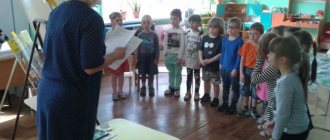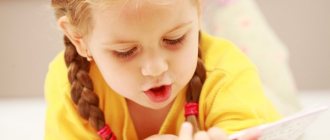MAGAZINE Preschooler.RF
“Development of fine motor skills in preschoolers” in the middle group of compensatory orientation1. Relevance of the project
“The hand is the human brain coming out”
I. Kant
The problem of developing fine motor skills in preschool children has been relevant for many years in the theory and practice of preschool education.
Fine motor skills are very important because through it such higher properties of consciousness as attention, thinking, coordination, imagination, observation, visual and motor memory, and speech develop. Back in the middle of the last century, it was found that the level of speech development of children directly depends on the formation of fine motor skills of the hands. If the development of finger movements lags behind, then speech development is also delayed, although general motor skills may be higher than normal. Teacher Vasily Sukhomlinsky wrote: “The child’s mind is at the tips of his fingers . And the famous German scientist Emmanuel Kant called the hands the visible part of the cerebral hemispheres. Manual skills were successfully used in working with children by the Italian humanist and teacher, the author of the world-famous method, Maria Montessori. Maria Montessori said that every movement of a child is another fold in the cerebral cortex.
The choice of the project topic is not accidental and is due to the fact that the compensatory group is attended by children with problems in speech development. Children with general speech underdevelopment are characterized by some lag in the development of the motor sphere. This fact is confirmed by analysis of anamnestic information. In a significant proportion of children, motor impairment is expressed in the form of poor coordination of complex movements, uncertainty in performing precisely dosed movements, and decreased speed and dexterity. Particular attention is required to consider the characteristics of fine motor skills of the fingers. Observing how a child fastens and unfastens buttons, ties and unties ribbons, laces, allows us to see insufficient coordination of fingers and hands; with special tests, pronounced slowness, getting stuck in one position, skipping individual elements and other features are more clearly revealed. Of course, the development of fine motor skills is not the only factor contributing to speech development. If a child has excellent, developed motor skills, but no one talks to him, then the child’s speech will not be sufficiently developed. That is, it is necessary to develop the child’s speech as a whole, communicate a lot and actively with him in everyday life, challenging him to talk, stimulating him with questions and requests. And plus to this, develop fine motor skills.
Thus, from all of the above, we can conclude that children with speech disorders have motor impairment to varying degrees, as well as deviations in the development of finger movements, since they are closely related to speech function. Therefore, the importance of the problem necessitated the development of a set of measures for the development of small muscles of the fingers, with the participation of parents and children of the middle group of a compensatory orientation.
2. Project participants
Children of the middle group of compensatory orientation, and their parents.
Teacher - speech therapist: Ferd Nadezhda Anatolyevna
Group teachers: Baranova Yulia Vladimirovna, Barannikova Tatyana Yurievna
3. Type of project: creative - gaming
4. Type of project: medium duration
5. Implementation period: November 2013 – May 2014
6. Theoretical foundations of the project
Features of the development of speech and fine motor skills in children with general speech underdevelopment
The movements of children with general speech underdevelopment are characterized by awkwardness, poor coordination, excessive slowness or, on the contrary, impulsiveness. This is one of the reasons that makes it difficult to master the simplest, vital skills and self-service skills.
In preschool age, many children, with whom long-term, targeted work has not been specifically carried out, cannot dress and undress independently or put their things away correctly. Particularly difficult for them is fastening and unbuttoning buttons, as well as lacing shoes.
Poor motor development affects other activities in children with general speech underdevelopment. Thus, their drawings are made with unsteady, curved lines that remotely convey the contour of the object.
Insufficiency of motor skills is to a certain extent due to the pronunciation problems inherent in children with general speech underdevelopment. Phonetically correct oral speech requires precise coordination of the movements of the speech organs. Motor impairments, manifested in children's gait and manual activity, are also reflected in their speech activity.
Scientists have proven that the development of the hand is closely related to the development of speech and thinking of the child.
The level of development of fine motor skills is one of the indicators of intellectual readiness for school education. Typically, a child with a high level of development of fine motor skills is able to reason logically: he has sufficiently developed memory and attention, and coherent speech.
Impaired motor skills, both articulatory and fine, can create difficulties in mastering written speech, lead to a negative attitude towards learning, and complications during the adaptation period to school conditions.
Therefore, in preschool age it is important to develop the mechanisms necessary for mastering writing, to create conditions for the child to accumulate motor and practical experience, and to develop manual skills.
Work on developing fine motor skills should begin long before the child enters school. By paying due attention to exercises, games, and various tasks for the development of motor skills and hand coordination, parents and teachers solve two problems at once: the development of speech and writing skills.
Thus, the study of theoretical material makes it possible to draw a conclusion: if the development of finger movements corresponds to age, then speech development is within normal limits.
Norms for the development of fine motor skills in preschool children
From 3 to 4 years:
- holding a pencil with his fingers
- collects and builds from 9 cubes
- takes small objects (crumbs, beads, grains of sand) with the tips of the thumb and forefinger
- repeats the simplest drawings (geometric figures) from the sample
From 4 to 5 years:
- draws straight horizontal and vertical lines
- colors simple shapes
- copies capital block letters
- draws a simple house (square and roof), a person (2–3 body parts)
- folds paper more than once
- strings medium-sized beads onto thick fishing line or wire; — — — identifies objects in the bag by touch
- sculpts from plasticine, laces shoes.
From 5 to 6 years
- copies complex drawings, letters (when copying, can make a mirror image, this is the norm for up to 8 years)
From 6 to 7 years
- fully masters fine motor skills
- can perform complex movements (tying shoelaces, playing a keyboard or string instrument, braiding hair, darning).
7. Purpose and objectives of the project
The goal of the project: to improve the system of work on the development of fine motor skills as a means of speech development in preschool children.
Project objectives:
- To study theoretical aspects of the development of fine motor skills in preschool children as a means of improving speech. Analyze and collect information from various sources.
- Develop long-term planning for the project.
- Find out the educational needs of parents and the level of their competence in matters of the development of fine motor skills as a means of speech development, establish contact with its members, and agree on the educational impact on the child.
- Get parents interested in using information and methodological stands.
- Develop and accept common requirements for parents and children, a common approach to education.
- Develop gaming, cognitive, sensory, and speech abilities, taking into account the individual and age characteristics of the child.
- Replenish the subject-development environment with manuals and simulators for the development of fine motor skills.
- Involve parents in joint work on the production of a sensory book as a means of developing fine motor skills and speech in children of the middle group of compensatory orientation.
- Expected results
- The survey revealed an increase in the pedagogical competence of parents in matters of the development of fine motor skills.
- Parents are actively involved in the correctional and developmental process for the development of fine motor skills as a means of improving speech.
- Parents independently use visual material to create a collaborative sensory book.
9. Effectiveness of these results
10. Possible risks
- Poor use of visual material to create sensory book pages.
- Difficulties interacting with parents.
11. Practical significance of the project
The practical significance of the project lies in the fact that the proposed system for creating a sensory book for the development of fine motor skills, as a means of improving speech, diagnostic material for identifying the competence of parents on the development of manual motor skills and the need for the use of theoretical material can be implemented by teachers, speech therapists and interested parents.
12. Project description
Project implementation stages
Stage 1 - preparatory (information and analytical).
Tasks:
- Find out the educational needs of parents and their level of competence in matters of developing fine motor skills, as a means of improving speech, and establish contact with its members. (Annex 1)
- Teachers determine the topic, goal and objectives, content of the project, predicting the result.
- Discuss the project with parents, find out the possibilities, funds necessary to implement the project, determine the content of the activities of all project participants.
- Prepare visual material for working with children and parents.
- Collect and study information (search for information on the Internet and other sources).
To solve these problems, we begin our work with a survey. Having obtained the real picture, based on the collected data, you can analyze the characteristics of the family and family upbringing of the child, identify the level of competence of parents in matters of speech development, and develop tactics for your communication with each parent. This will help to better navigate the pedagogical needs of each family and take into account its individual characteristics.
Stage 2 - main (practical).
Tasks:
- To develop and test a system of methodological activities for parents on the speech development of preschool children.
- “sensory book” master class for parents on the production of manuals and simulators at home on the topic of the project. (Appendix 2)
- Conduct individual consultations (if necessary).
- Replenish information and methodological stands with theoretical materials. (Appendix 3)
- Conduct a round table with parents to approve the name and design of a sensory book for the development of fine motor skills as a means of improving speech. (Appendix 4)
These forms of work make it possible to involve parents in active participation in the correctional process, presuppose the establishment of trusting relationships between teachers and parents, and awareness by parents of the role of the family in the education and upbringing of the child.
Stage 3 - final (control and diagnostic).
Tasks:
- To analyze the effectiveness of teachers’ work with parents on the development of fine motor skills as a means of improving speech. (Appendix 5)
- Presentation of a sensory book. (Appendix 6)
- Broadcast work experience on this topic for teachers.
- Post photographs of project activities on the preschool educational institution’s website.
- Long-term project implementation plan
Conclusion
In conclusion, we can say the following: overcoming the underdevelopment of small muscles of the hand, inconsistency in hand actions, and specific features of the motor sphere must begin long before entering school.
Exercises to develop fine motor skills bring triple benefits to the child: the hands acquire good mobility and flexibility, the stiffness of hand movements disappears, and they prepare for mastering writing. They develop his artistic taste, which is useful at any age and, thirdly, it has been proven that the development of hands is associated with the development of the child’s speech and thinking. Therefore, in our kindergarten, special attention is paid to the development of fine motor skills. Usually, children in the preparatory group for school, who are preparing to master a complex skill - writing, experience an urgent need for this. But in our kindergarten there are groups of different ages, so games to develop fine motor skills are played with all children from 3 to 6 years old. Every day we stretch our fingers: we do massages, practice with lacing, and play finger games. It is necessary and useful to use games and exercises to train fingers in combination with children's speech.
All exercises are carried out in a playful way. Their complexity is selected depending on the level of development of fine motor skills of children’s hands. When performing many exercises, all children experience difficulties at first. But when you do them regularly and use a variety of techniques, the whole set of exercises becomes a powerful means of increasing the performance of the cerebral cortex, stimulating the development of the child’s thinking.
| Next > |
Work program “Skillful Hands”
M. M. Koltsova, Doctor of Medical Sciences, professor of physiology, believes that “there is every reason to consider the hand as an organ of speech - the same as the articulatory apparatus.
From this point of view, the projection of the hand is another speech area of the brain.” According to Koltsova’s observations, children who make numerous movements with their fingers develop speech faster than others. If you specifically train small hand movements, speech development can be significantly accelerated.
The development of fine motor skills is also important because the child’s entire future life will require the use of precise, coordinated movements of the fingers, which are necessary to dress, draw, write, and perform many everyday and educational activities.
In order for a future first grader to skillfully handle a pen, pencil, felt-tip pen, brush, and then a computer keyboard, it is necessary to develop the movements of his fingers, striving to ensure that they are free, confident, and coordinated.
Work on developing fine motor skills should begin long before the child enters school. Parents and we educators, paying due attention to exercises, games, various tasks for the development of fine motor skills and coordination of hand movements, solve two problems at once: we indirectly influence the general intellectual development of the child; We prepare you to master writing skills, which will help you avoid many problems in school in the future.
Purpose of the program:
Develop and improve fine motor skills and hand coordination through play massage, exercises and games.
Tasks:
Teach children to use their hands, develop fine motor skills, manual dexterity, and coordination of movements.
Develop imagination, thinking, instill the ability to analyze and synthesize, train logic.
To develop children’s general speech skills and enrich their vocabulary.
Promote the development of objective activity, the development of tactile sensitivity; develop the eye, visual attention.
Develop artistic taste, design skills, develop an interest in drawing, making patterns, and symmetrical arrangement of figures.
Develop creative abilities.
Foster kindness and initiative; cultivate perseverance and patience.
Program
involves one lesson per week.
The duration depends on the age group.
Medium group – 20 min.
Children's work is assessed throughout the entire training period. The individual characteristics of each child are taken into account. The main indicator of the results obtained is the sum of the necessary knowledge, skills and abilities that the child must master in a certain time. The assessment criteria can be games during classes, allowing children to evaluate their own achievements, as well as test tasks at the beginning and end of the school year, which determine the level of their development.



